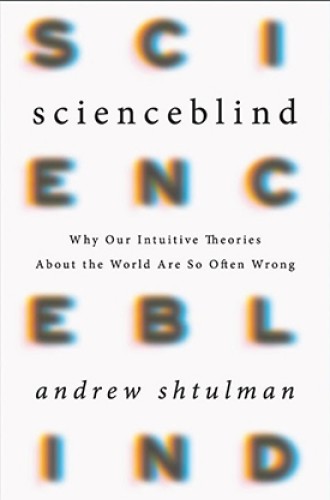Why scientific thinking matters for society
Andrew Shtulman's book isn't just about understanding data. It's about moral concern.
The things we know intuitively about the world are often false. For example, for many centuries, people intuitively knew that the world was flat—until scientific observation showed that it was round. But even then, says cognitive developmental psychologist Andrew Shtulman, “our untutored explanations for how the world works” continue to shape our thinking:
Like a palimpsest, our minds record new theories (scientific theories) on top of old theories (intuitive theories) such that both theories can become active at the same time, providing competing explanations or competing predictions. . . . In some cases, our scientific knowledge may be nothing more than a veneer, thinly covering misconceptions forged decades earlier, when we were children.
Many of Shtulman’s examples focus on our holistic perception of objects and the limitations of our point of view. It’s easier for children to think of an ice cube as a “source” of cold than to think of heat as the collective energy of the molecules within a physical system. Similarly, our perception of the world within a human timeframe leads us to perceive “geological systems in terms of discrete events, not continuous processes.” And our tendency toward essentialism leads us not only to think that baby pigs will grow up to be adult pigs, but that transplanted organs might somehow infuse recipients with parts of their donors’ personalities.
The book has garnered significant praise, and for good reason. There are many examples around us of people relying on intuition to interpret the world. Although there is overwhelming scientific evidence in support of climate change, our nation has pulled out of the Paris climate accord. My local public radio station recently covered a growing measles outbreak among Somali immigrants who refused to vaccinate their children. And in a bit of celebrity news that borders on the absurd, NBA star Kyrie Irving repeatedly argues that the earth is flat. In the face of such events, it’s worth being reminded that whether the earth is round or flat is not a matter of opinion. Science is about empirical data, and our ability to collect and harness this data has yielded humanity an astonishing measure of control over our personal and social health, our environment, and even space.
But if the book were aimed toward helping us better understand the scientific method, as Shtulman claims in the introduction, we might expect him to offer a clear summary of that method. If it were aimed toward helping educators better overcome their students’ inability to process scientific knowledge, we might expect the book to follow a structure more clearly addressed toward the educator’s challenges. Instead, Shtulman begins by challenging the ignorance surrounding some of humanity’s least controversial scientific discoveries—according to modern standards—and steadily pushes toward a chapter on ancestry, in which he invokes the problem of evil:
Why would an omnipotent being use natural selection as a tool for creation? Natural selection is a cruel process, as noted in Chapter 12. Most organisms die of starvation, predation, or disease before reaching reproductive maturity. Does God delight in watching orcas drown baby seals by the dozens?
I don’t believe this question of theodicy is Shtulman’s primary aim in the book, but neither is it inconsequential. The whole of the prose builds toward it. Earlier chapters are written from a dispassionate point of view, but as he moves away from discussions of gravity and tectonic drift toward the problems of life, illness, and genetics, he inserts more of himself into the prose. He uses the pronoun “I” more frequently. He brings his son and daughter into anecdotal examples. He shortens his paragraphs and uses more humor.
A subtle, subtextual derision of religion runs through the book—as though it were written atop a belief that faith and science are fundamentally opposed. But it’s a fragile faith that needs to compact all creation into a seven-day period of exactly 168 hours or to deny all the evidence that points toward evolution, the Big Bang, and the idea that our thoughts and personalities materialize from the workings of our brains. Such thinking creates needless divides between Christians and those who are looking for answers to the questions that science cannot address—questions about meaning, purpose, and morality.
Shtulman writes with the greatest fervor where matters of science and moral concern most closely coincide. Both in his conclusion and in an interview with New York magazine, Shtulman recalls his surprise when a teaching colleague argued that the development of moral cognition was more socially significant than the development of scientific cognition:
Our understanding of natural phenomena has widespread social implications as well. Vaccination, pasteurization, stem cell research, cloning, fertility treatment, genetic modification of food, genetic modification of microbes, antibiotics, pesticides, cryogenics, space exploration, nuclear power, climate change: these science-laden issues affect society as a whole. It is important not just that scientists understand them but that everyone understands them.
Here, Shtulman is right, and because he’s right, Scienceblind is worth reading. It’s also important in the way it challenges Christians to reconcile faith and science. The book’s greatest value lies not in how it helps us teach gravity to third-graders but in how it challenges us to sympathize with the intelligent, educated people around us and the doubts they express.





